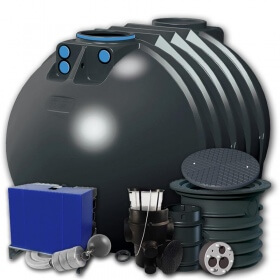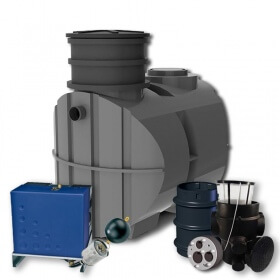- favorite 29 likes
- remove_red_eye 65580 views
- comment 0 comments

RAINWATER MANAGEMENT SYSTEMS
By analyzing the results of domestic water use, it can be concluded that over 50% of the water used can be replaced with water of lower quality, i.e. rainwater. It is perfect for flushing toilets which use approx. 45 liters of water per day, washing floors and cars, where we use over 70 liters per person per week. To this you can add the use of water for washing - about 80 liters per day for a family of 4. In this case, if we replace tap water with ordinary rainwater, we will achieve lower consumption of cleaning agents and greater protection of washing machine elements against limescale deposits, because rainwater is soft water. The awareness of the use of rainwater in such a broad spectrum calls into question the current habits related to the use of water.
Why is it worth saving water? There are many reasons and they are often very interrelated. The cost of 1 m3 of food-grade quality water increases every year. This is due to two issues: rising costs of water extraction and treatment, and increasingly expensive wastewater treatment processes. This trend is likely to being continue in the future. Another factor is the so-called "Tax on rain", that is, a fee for using the sewage system, both sanitary and rainwater (introducing rainwater). The fees are intended to cover the costs related to the operation, maintenance and administration of the sewage networks. The tax is currently not compulsory, but local governments have the right to introduce a "rain tax" and are increasingly doing so. The last aspect is the use of rainwater collection systems as a small retention, i.e. a project aimed at extending the time of water circulation by increasing the ability to retain rainwater, retain pollutants and reduce water energy losses, i.e. activities that relieve the sewage network. Water surplus as a result of precipitation can be collected in reservoirs for use during its shortage. Water is becoming an increasingly valued resource, so why waste any usable water by draining it down the drain and pay extra for it?
How does the rainwater management system work?
The system mainly uses rainwater collected from the roofs of buildings. However, it is also possible to collect it from hardened areas, such as yards, parking lots, driveways, etc. Water flowing from the roof through a system of gutters and downspouts goes to a reservoir, usually an underground rainwater tank. Typically, before the tank is full, the water is purified through a filter placed along the drain. The stored rainwater is pumped to the point of demand by a pump in a tank or in a building.
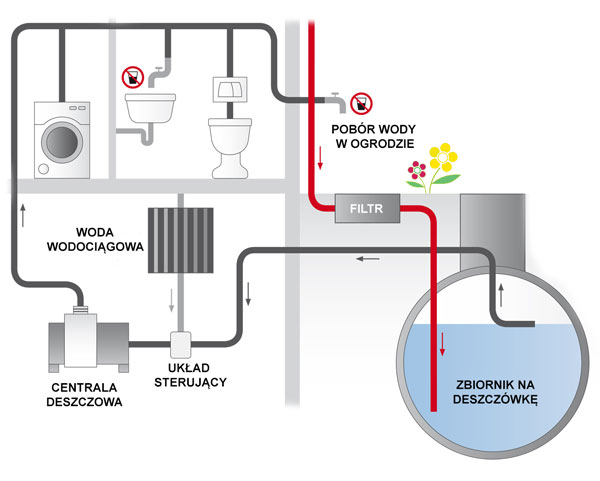
Where:
Zbiornik na deszczówkę - Rainwater tank,
Układ sterujący - Control system
Centrala deszczowa - Rainwater central
Filtr - Filter
Woda wodociągowa - Tap water
Pobór wody w ogrodzie - Water intake in the garden
Rainwater collection systems
Systems can be divided into two main groups: garden systems, in which water is used for watering greenery and gardening, and systems using water in the building. These can be household buildings, but also commercial and public utility facilities, e.g. medical facilities, hotels, SPA centers or gas stations.
Garden systems for rainwater management
Garden systems include devices that allow the use of rainwater for external purposes, i.e. most often for irrigation of green areas, as well as for external cleaning or washing vehicles. To assemble the simplest set for watering the garden, you need: a properly selected tank for the roof catchment area and paved area, a filter, a suction pump and a connected garden hose.
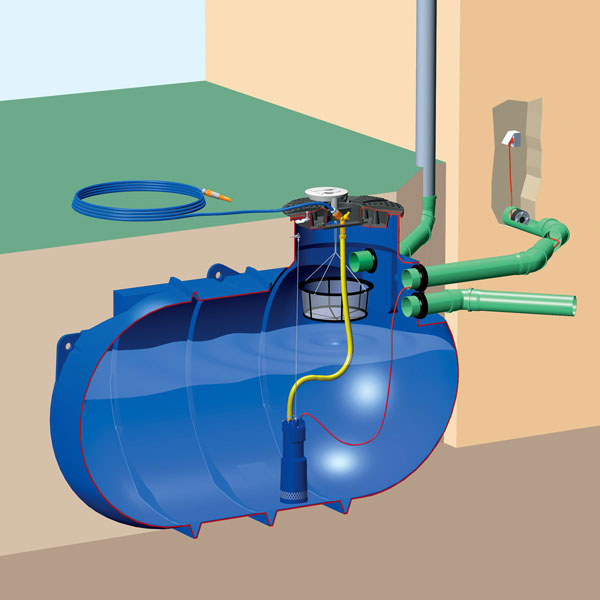
One of the key elements in collecting rainwater is the tank. The choice of tank size is a key consideration in system design. Too small its volume may result in insufficient water supply for the intended purposes, while a too large tank may result in a long period of water retention in it, which will negatively affect its quality. The tank is always selected individually, taking into account various parameters of the place and object. There are many types and kinds of tanks available on the market, which we can distinguish e.g. due to their location on the property. It is about above-ground and underground tanks. Tanks are also differentiated in terms of volume: above-ground tanks usually have the possibility of storing several hundred liters, and underground ones can have a capacity of up to several dozen m3. The water in the underground tank is cool and protected against the growth of bacteria. It is best to plan such a tank before starting construction. Rainwater tanks are made of various materials. The most common raw material used in the manufacturing process of the container is pure polyethylene (PE) granules. The highest quality of tanks is obtained when using rotational molding. Exceptional parameters are achieved by monolithically formed tanks (one element). They are 100% waterproof, more resistant to stresses and achieve high stability. The capacity of monolithic tanks ranges from 1500 l to 10000 l. High-class tanks have a reinforced structure, strong ribbing and are made of good raw material. Concrete structures are also suitable for rainwater, e.g. concrete rings known from the construction of wells. At first, a circle is laid out and the bottom of the reservoir is poured. Then the next circles are placed and the whole is connected with a special cement mortar with a sealant. The end of the tank is a cone with a steel cover. If we plan to connect to the sewage system, and until then we use a concrete or plastic septic tank, a good solution is to transform such a tank into a rainwater management system. Of course, the container should be thoroughly cleaned and disinfected beforehand.
The water that runs off the roofs is relatively clean, comparable to the directly collected rainwater. However, before the water goes to the tank, it is worth to let it flow through a filter that will stop larger mechanical impurities, such as leaves or twigs. We can choose from many filter options, which can generally be divided into external, i.e. placed in front of the tank, or internal, i.e. located in the tank. There are collecting filters that work on the principle of baskets in which impurities are deposited, in such solutions the user is obliged to periodically inspect the filter and empty it of impurities or filter sedimentation tanks. There are also flow-through filters that discharge pollutants, for example, into the sewage system. For standard rainwater collection sets, filters are usually basket filters.
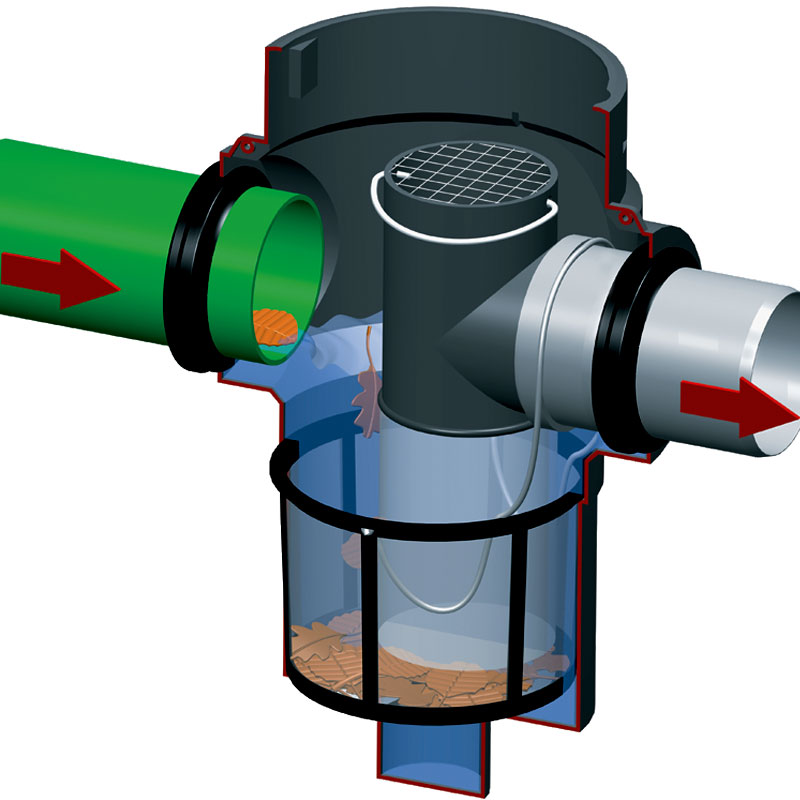

In order to be able to use the rainwater accumulated in the tank, you need a suitable pump. The market currently offers many solutions, but what we choose depends on the intended use of the water, i.e. the way the rainwater is used. Pumps made of stainless steel should be selected as the rainwater has a slightly acidic pH. One of the simplest solutions and undoubtedly cheaper is a portable garden pump - a self-priming pump that allows you to water the lawn of a small garden. The downside of this solution is the need to assemble and disassemble the pump set with each use, and after the growing season it will be possible to remove it from the tank and hide it, protecting it against winter. Submersible pumps are another solution. The advantage of this solution is noiseless operation and optimal efficiency, i.e. lifting height and water pumping distance. Such pumps can be divided into low NC and high DC pressure pumps. High pressure submersible pumps can be used for automatic irrigation of green areas. Garden sets use submersible impeller pumps with low energy consumption, pressure switching (activated during water intake), having several operating modes. Modern pumps are equipped with a system of protection against dry running - in the event of a lack of water, the pump stops working.
Additional equipment for garden sets is, for example, a cover with a double, integrated, brass quick-connector for water intake and a childproof lock, and a box with an automatically wound hose. A simple hose connected to the water jet pump is also sufficient to use the garden system. You can use an automatic irrigation system for green areas or connect to several water intakes on the property. The garden system is safe, and when it is overfilled with rainwater, it has a drainage channel, which is most often directed to the absorbent well, sewage system, drainage ditch or infiltration system with absorbent boxes or wells. Unfortunately, in addition to drainage on their own land, which requires soil with good permeability, most ways of draining excess water require approval from the authorities.
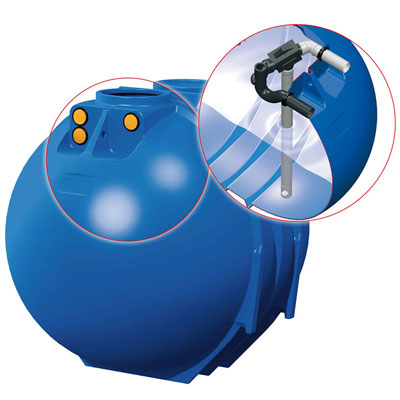
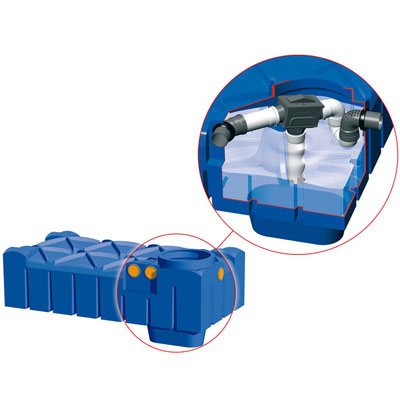
Underground home and garden systems for rainwater
Home and garden systems are slightly more technologically complex solutions. Rainwater is most often used for flushing toilets, washing floors and washing. Apart from the reservoir, filters and pump, separate water pipes are required.
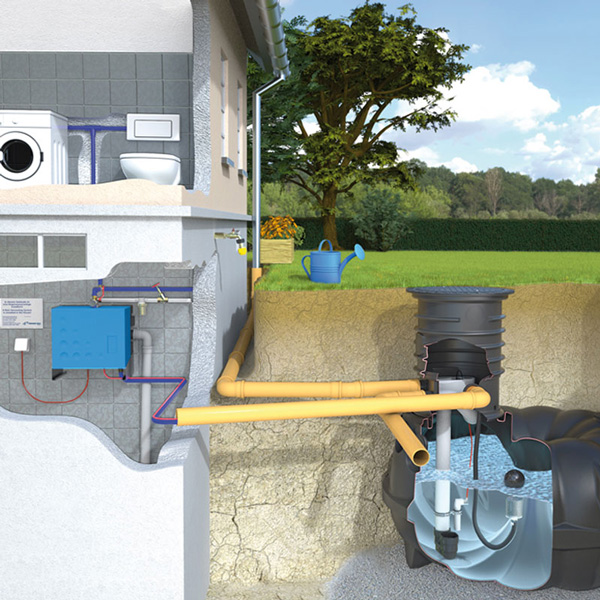
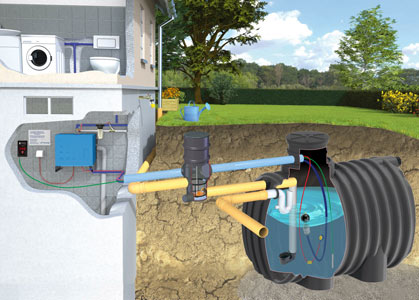
Designing additional pipes for rainwater supply to the target receivers is easiest in the design phase of new buildings, while in existing buildings, plastic pipes can be used. Rainwater is most often used for flushing toilets, washing floors and washing.
When using rainwater in a building, it is worth considering an alternative solution to a submersible pump, which is to install rainwater central in the garage or in the boiler plant. It is a device built, among others from a pump, a handy city water tank and from automation, which allows for uninterrupted operation, even in the absence of rainwater in the tank. In this case, the control panel automatically switches to the use of tap water. The selection of the appropriate device is basing of the required capacity and pressure, necessary to service the points of water intake. Therefore, important data already at the design stage of the system include information on the method and direction of use of the rainwater collected in the tank and the length and diameter of the suction and discharge lines that will determine the pressure losses. In case of a large distance between the tank and the device in the building (more than 20 m), it may be necessary to use a booster pump in the tank. In commercial and public facilities, the device dedicated to pumping rainwater is more technologically advanced. Usually it has more than one pump, a larger handy tank (approx. 100 l) and a more complex control system. There are also devices consisting of a control panel (including emergency topping up of the system with tap water) located in the building. Complete home and garden systems offer a continuous supply of water regardless of the content of the rainwater tank. The submersible pump is more efficient, while the rainwater central is a system integrated in one box.
Additional elements
In order to ensure the optimal quality of the water used and to adapt the installation to the individual needs of the user, several additional accessories can be used, affecting the cleanliness of the water consumed by the pumping device. On the suction line, i.e. between the tank and the rainwater center, an additional filter can be installed, filled with a cartridge with openings of e.g. 25 μm or with active carbon, which will eliminate unsuitable water parameters, such as smell, color, turbidity. For the most demanding users, the installation of UV filters is also planned. These devices sterilize the water in terms of the bacterial fauna that lives in it. The suction line can be ended in the tank with a suction basket, which will stop any mechanical impurities. If the basket is additionally suspended on a float, the pump will start to draw water from the surface several centimeters below the water surface, on which, for example, pollen from plants, which are lighter than water, may float. The water flowing into the tank is directed by the so-called a calmed inlet towards the bottom of the tank, however, the stream does not flow directly to the bottom, but flows above it, so that it does not disturb the sediment accumulating at the bottom, which is formed from substances heavier than water. Due to uneven rainfall, the tank may overfill from time to time. It is therefore worth equipping it with an emergency overflow, which will direct excess water, e.g. to the drainage system in the ground or to the sewage system. The overflow siphon prevents unpleasant odors from the sewage system from getting into the tank, and further onto the property, and may also contain rodent security. There are also a number of elements that facilitate the use of rainwater, e.g. a garden hose that coils and hides in the rising pipe of the tank, a solar-powered pump or a decorative water intake point. On the other hand, the bolted covers protect against uncontrolled opening, e.g. by children.
Designing the size of the tank
The basis of the system is the tank. The choice of tank size is a key consideration in system design. Too small its volume may result in insufficient water supply for the intended purposes, while a too large reservoir may result in a long water retention period, which will adversely affect its quality. The reservoir is always selected individually, taking into account the amount of rainfall, the size and type of the catchment area, and the efficiency of filtering devices.
Calculation of the water yield
V = H · A · s · f [l]
Where:
H - precipitation height [m2],
A - roof area in the horizontal projection [m2],
s - runoff coefficient,
f - filter efficiency.
To get your daily income of rainwater, divide the result by 365.
The amount of precipitation H depends on the location of the investment and the region of the country. To determine the sum of annual waste (long-term average value) for a region or city, it is worth using the meteorological information presented on the website of the Institute of Meteorology and Water Management.
The s runoff coefficient depends on the roof material. The amounts to be taken are presented in the table below.
Roofing | Runoff coefficient |
Steep roofs made of bitumen, plastic, sheet metal | 0,80 |
Steep roofs covered with ceramic and cement tiles | 0,75 |
Flat roofs covered with bitumen, plastic, sheet metal | 0,70 |
Flat roofs with a gravel layer | 0,30 |
Steep roofs covered with vegetation | 0,25 |
"Green Roofs" | 0,20 |
The efficiency of the filter depends on its quality. Modern self-cleaning filters achieve efficiency from 0.85 to 1.
Calculation of rainwater demand
Structure of water consumption | Use [dm3/M x d] | % | |
| min. - max. | average | ||
Drinking and cooking | 3-5 | 4 | 3 |
Washing dishes | 10-15 | 12 | 10 |
Washing the body | 10-15 | 12 | 10 |
Shower or bath in the tub | 25-40 | 33 | 26 |
Flushing the toilet bowl | 30-45 | 38 | 30 |
| Laundry | 16-20 | 18 | 15 |
| Cleaning and other needs | 6-10 | 8 | 6 |
| Together | 100-150 | 125 | 100 |
| Washing the car: with a bucket with a hose Watering greens with a hose | 20-30 dm3/car 50-100 dm3/car 10-20m3/min | ||
Rainwater tanks are designed so that they can store the stock for a certain number of days without rainfall. The most common period of 21 days. Therefore, the value of the total water requirement of the building should be multiplied by this value.
Having calculated the values of rainwater demand and the amount of water that can be obtained, you can successfully choose a rainwater tank from the manufacturers' catalogs.
Related products
Gama Rainjet garden system
- Rainwater tank with filter, pump, hose, garden box
- Auto pressure pump
- Volume from 1000l to 3500l
Garden set Standard with Ecoline II tank
- Use of rainwater for the garden
- Reinforced tank construction Ecoline II
- Capacities from 1700 l to 7500 l
Home and garden set Standard Blueline II
- Rainwater management system for the home and garden
- Serves toilets, urinals, washing machines and garden outlets
- Capacities from 5200l to 10000l and Domestic C-plus control panels
Home and garden set Standard Ecoline II
- C-Plus rainwater control panel
- Maxi filter - 350 m2 of roof
- Reinforced tank construction
- Capacities from 3400 l to 7500 l



